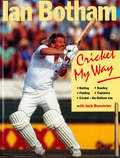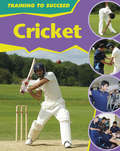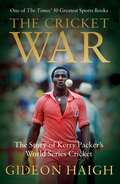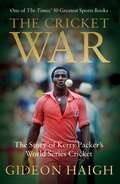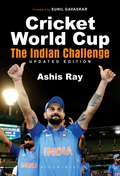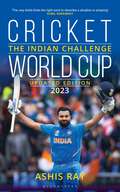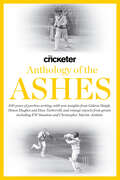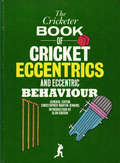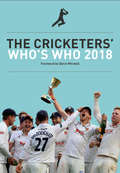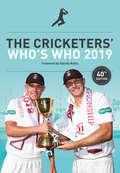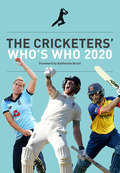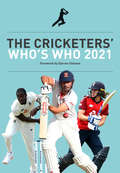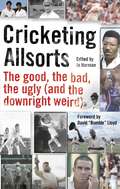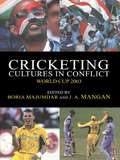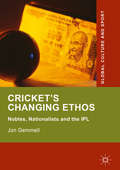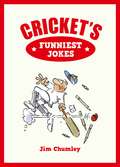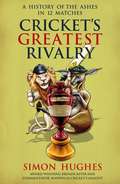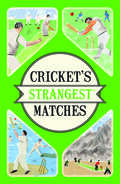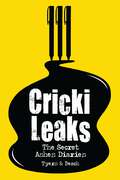- Table View
- List View
Cricket My Way
by Ian BothamIan Botham’s approach to cricket is simple: keep fit, play hard, aim to win and, above all, enjoy the game. His advice on the skills is equally straightforward: attempt to master the basics … But never be afraid to try something new.
Cricket (Training to Succeed)
by Rita StoreyLearn what it takes to become a professional sportsperson, perhaps even a star of the future! Includes 'coach's notes' - training tips for the reader and advice and contact information for getting on further in the sport.
Cricket Player with Bowling and Batting Ends (large print)
by RnibThere are three images on this page: a cricket bat and ball, a player bowling, and a plan view of the bowling and batting ends of the pitch. Each one is surrounded by a dashed line image border. There is a locator dot shown, which will be at the top left of the page when the image is the correct way up. The cricket bat and ball can be found at the top left of the page. The bat is seen from the front in a horizontal position with the blade of the bat to the left and the handle to the right. The ball can be found down the page from the bat's handle. The player is bowling is in the bottom left of the page. He is seen from the side and faces right so that only one eye and ear can be found. His head is just above the centre of the image. To the left of this he has one arm held up. Down the page is his body and to the right of this his bowling arm is held out to the right, having just released the ball up and to the right. Down from this arm, one of the stumps can be found and to the left of this is one of the player's legs, bent at the knee with a foot on the ground at the bottom of the image. Left of this is his other leg, bent at the knee with its foot off the ground. The diagram of the pitch ends is on the right of the page. The various pitch markings are shown and labelled, with a key to the abbreviations used in the centre of the image. The bowling end is in the top of the image and the batting end, with a top view of a batsman up from the wicket, at the bottom. The part of the pitch between the ends has not been shown because of space limitations. The length of the pitch, from wicket to wicket, is 22 yards (20.12 metres).
Cricket Player with Bowling and Batting Ends (UEB contracted)
by RnibThere are three images on this page: a cricket bat and ball, a player bowling, and a plan view of the bowling and batting ends of the pitch. Each one is surrounded by a dashed line image border. There is a locator dot shown, which will be at the top left of the page when the image is the correct way up. The cricket bat and ball can be found at the top left of the page. The bat is seen from the front in a horizontal position with the blade of the bat to the left and the handle to the right. The ball can be found down the page from the bat's handle. The player is bowling is in the bottom left of the page. He is seen from the side and faces right so that only one eye and ear can be found. His head is just above the centre of the image. To the left of this he has one arm held up. Down the page is his body and to the right of this his bowling arm is held out to the right, having just released the ball up and to the right. Down from this arm, one of the stumps can be found and to the left of this is one of the player's legs, bent at the knee with a foot on the ground at the bottom of the image. Left of this is his other leg, bent at the knee with its foot off the ground. The diagram of the pitch ends is on the right of the page. The various pitch markings are shown and labelled, with a key to the abbreviations used in the centre of the image. The bowling end is in the top of the image and the batting end, with a top view of a batsman up from the wicket, at the bottom. The part of the pitch between the ends has not been shown because of space limitations. The length of the pitch, from wicket to wicket, is 22 yards (20.12 metres).
Cricket Player with Bowling and Batting Ends (UEB uncontracted)
by RnibThere are three images on this page: a cricket bat and ball, a player bowling, and a plan view of the bowling and batting ends of the pitch. Each one is surrounded by a dashed line image border. There is a locator dot shown, which will be at the top left of the page when the image is the correct way up. The cricket bat and ball can be found at the top left of the page. The bat is seen from the front in a horizontal position with the blade of the bat to the left and the handle to the right. The ball can be found down the page from the bat's handle. The player is bowling is in the bottom left of the page. He is seen from the side and faces right so that only one eye and ear can be found. His head is just above the centre of the image. To the left of this he has one arm held up. Down the page is his body and to the right of this his bowling arm is held out to the right, having just released the ball up and to the right. Down from this arm, one of the stumps can be found and to the left of this is one of the player's legs, bent at the knee with a foot on the ground at the bottom of the image. Left of this is his other leg, bent at the knee with its foot off the ground. The diagram of the pitch ends is on the right of the page. The various pitch markings are shown and labelled, with a key to the abbreviations used in the centre of the image. The bowling end is in the top of the image and the batting end, with a top view of a batsman up from the wicket, at the bottom. The part of the pitch between the ends has not been shown because of space limitations. The length of the pitch, from wicket to wicket, is 22 yards (20.12 metres).
The Cricket War: The Story of Kerry Packer's World Series Cricket
by Gideon HaighOne of The Times' 50 Greatest Sports BooksIn May 1977, the cricket world awoke to discover that a thirty-nine-year-old Sydney Businessman called Kerry Packer had signed thirty-five elite international players for his own televised 'World Series'. The Cricket War is the definitive account of the split that changed the game on the field and on the screen.In helmets, under lights, with white balls, and in coloured clothes, the outlaw armies of Ian Chappell, Tony Greig and Clive Lloyd fought a daily battle of survival. In boardrooms and courtrooms Packer and cricket's rulers fought a bitter war of nerves.A compelling account of the top-class sporting life, The Cricket War also gives a unique insight into the motives and methods of the man who became Australia's richest, and remained so, until the day he died. It was the end of cricket as we knew it – and the beginning of cricket as we know it.Gideon Haigh has published over thirty books, over twenty of them about cricket. This edition of The Cricket War, Gideon Haigh's first book about cricket originally published in 1993, has been updated with new photographs and a new introduction by the author.
The Cricket War: The Story of Kerry Packer's World Series Cricket
by Gideon HaighOne of The Times' 50 Greatest Sports BooksIn May 1977, the cricket world awoke to discover that a thirty-nine-year-old Sydney Businessman called Kerry Packer had signed thirty-five elite international players for his own televised 'World Series'. The Cricket War is the definitive account of the split that changed the game on the field and on the screen.In helmets, under lights, with white balls, and in coloured clothes, the outlaw armies of Ian Chappell, Tony Greig and Clive Lloyd fought a daily battle of survival. In boardrooms and courtrooms Packer and cricket's rulers fought a bitter war of nerves.A compelling account of the top-class sporting life, The Cricket War also gives a unique insight into the motives and methods of the man who became Australia's richest, and remained so, until the day he died. It was the end of cricket as we knew it – and the beginning of cricket as we know it.Gideon Haigh has published over thirty books, over twenty of them about cricket. This edition of The Cricket War, Gideon Haigh's first book about cricket originally published in 1993, has been updated with new photographs and a new introduction by the author.
Cricket World Cup: The Indian Challenge
by Ashis RayCricket World Cup: The Indian Challenge is the most comprehensive offering on the subject; as eminently readable as essential reference. It covers all 10 previous World Cups in detail from an Indian perspective, highlighting the 1983 and 2011 competitions, which India won. The book has a guide chapter to the next World Cup, starting on 14 February 2015. The book is first scheduled to be launched by February 2015.It will be again re-launched in May 2015, with the “guide” chapter replaced by a review of the 2015 World Cup, thereby rendering the product a four year shelf life.
Cricket World Cup: The Indian Challenge (Updated Edition)
by Ashis RayThis is a riveting read for a cricket lover, especially an India fan. A remarkable, eye-witness history of the Cricket World Cup from an Indian perspective the book details the little-known story of India's turning point in one-day cricket in Guyana, when Kapil Dev's team in March 1983 beat the previously unassailable West Indies in their backyard. It also reminds readers of the tremor that was felt in the cricketing world when India repeated the success at Manchester in the World Cup 10 weeks later, before defeating the same side in the final two weeks later. It relives India's forgotten triumph in the 1985 World Championship and the rekindling of hope when Sourav Ganguly's team finished as runners-up in the 2003 World Cup. The book further depicts how MS Dhoni planned victory, together with Sachin Tendulkar inspiring Yuvraj Singh to perform at his best, in the 2011 tournament.The book is embellished by illuminating reports and scores on each India match and every semi-final and final in the World Cup since its inception. Finally, it discusses India's prospects in the 2019 World Cup.
Cricket World Cup: The Indian Challenge (Updated Edition 2023)
by Mr Ashis RayCricket World Cup: The Indian Challenge is a complete match by- match catalogue of India in the Cricket World Cup with scorecards. It details the little-known story of India's turning point-a victory in March 1983 over the then invincible West Indies in Guyana, before Kapil Dev's team sensationally lifted the World Cup three months later. It relives India's forgotten triumph in the 1985 World Championship in Australia. It depicts how Sachin Tendulkar inspired Yuvraj Singh to perform at his best in India's successful campaign in the 2011 World Cup.And why the Indians disappointed in 2015 and 2019, but have home advantage in 2023.
The Cricketer Anthology of the Ashes
by Huw TurbervillThis superb anthology showcases 100 years of peerless writing on the Ashes from The Cricketer magazine. Insightful new contributions from today's best cricket writers including Gideon Haigh, Simon Hughes and Huw Turbervill sit alongside vintage reports, features and comment pieces from greats including Pelham 'Plum' Warner, EW Swanton and Christopher Martin-Jenkins. Relive the brilliance of Don Bradman, Harold Larwood, Jim Laker, Geoffrey Boycott, Ian Botham, Shane Warne, Adam Gilchrist, Andrew Flintoff and others in this fresh new take on the giants of the game. Featuring Simon Hughes' ultimate Ashes XI, Gideon Haigh's five greatest series and lively detours into the controversies and scandals which have defined sport's greatest contest, this definitive history from the world's foremost cricket magazine is as colourful as the Ashes themselves.
The Cricketer Book of Cricket Eccentrics and Eccentric Behaviour
by Christopher Martin-JenkinsLong out of print, the late Christopher Martin-Jenkins’ humorous book The Cricketer Book of Eccentric Behaviour and Cricket Eccentric Eccentrics is at last available as an ebook. A noted cricket commentator, Editor of The Cricketer from 1980 and President of the Cricket Society from 1998 to 2008, Christopher had an encyclopaedic knowledge of cricket including a wealth of anecdotes and amusing stories which are regaled with humour in this book which was a popular best-seller when first published in the 1980s.
The Cricketers' Who's Who 2018
by Jo Harman Ben GardnerThe Cricketers’ Who’s Who is the essential guide to the English cricket season, and is the must-read accompaniment for anyone interested in the English game, including fans, players and journalists. Produced by All Out Cricket in association with the Professional Cricketers’ Association, 2018 marks the 39th edition of the English cricket bible. Now get it on your smartphone or tablet for easy reference at the match, watching TV or listening to Test Match Special.
The Cricketers' Who's Who 2019
by Gareth BattyThe Cricketers’ Who’s Who is the essential guide to the English cricket season, and is the must-read accompaniment for anyone interested in the English game, including fans, players and journalists. Produced by All Out Cricket in association with the Professional Cricketers’ Association, 2019 marks the 40th edition of the English cricket bible. Now get it on your smartphone or tablet for easy reference at the match, watching TV or listening to Test Match Special.
The Cricketers' Who's Who 2020
by Benji MoooreheadThe Cricketers’ Who’s Who 2020 is the essential guide to the new cricket season and is the must-read and much-loved accompaniment for anyone interested in the English game. The 41st edition tells you all you need to know about every player from all 18 counties, as well as the England Women squad and the panel of first-class umpires. More than 400 players have answered questions ranging from the star players of the future to the hottest debates within the dressing room, giving readers a unique insight into everyone who will be competing this summer, from emerging youngsters to England stars such as Ben Stokes and Jofra Archer. This year’s foreword comes courtesy of England legend Katherine Brunt. The cherished reference book includes a thorough statistics section for every player and all counties, as well as profiles of the head coaches, and a review of how each county did last summer and how they’re shaping up for 2020.The pages of The Cricketers’ Who’s Who 2020 reveal the interesting, insightful, sometimes hilarious and often off-the-wall world of English cricket.
The Cricketers' Who's Who 2021
by Darren StevensThe Cricketers’ Who’s Who 2021 is the essential guide to the new cricket season and is the must-read and much-loved accompaniment for anyone interested in the English game.The 42nd edition tells you all you need to know about every player from all 18 counties, as well as the contracted women’s players.More than 400 players have answered questions ranging from the star players of the future to the hottest debates within the dressing room, giving readers a unique insight into everyone who will be competing this summer, from emerging youngsters to established England stars such as Jos Buttler, Ben Stokes and Jofra Archer.This year’s foreword comes courtesy of Kent legend Darren Stevens, the epitome of a county cricketer.The cherished reference book includes a thorough statistics section for every player and all counties, as well as profiles of the head coaches, and a review of how each county did last summer and how they’re shaping up for 2021.The pages ofThe Cricketers’ Who’s Who 2021 reveal the interesting, insightful, sometimes hilarious and often off-the-wall world of English cricket.
Cricketing Allsorts: The Good, The Bad, The Ugly (and The Downright Weird)
by Jo HarmanMore than any other sport, cricket highlights our peculiarities and quirks, our strengths and weaknesses – sporting or otherwise. It welcomes all-comers, no matter what their quirks or achievements. Cricketing Allsorts celebrates those oddities and records, and offers a lively portrait of the game and its players in all their glory and eccentricity. Presented in the form of 'top ten' lists and illustrated with photographs from through the ages, Cricketing Allsorts covers all aspects of the game, both on and off the field. It guides us through topics such as: - the top cricketing love affairs, featuring Keith Miller and Princess Margaret- the greatest bowing partnerships, including Wasim & Waqar, Laker & Lock and Ramadhin & Valentine- the best fictional cricketers, including Hooker Knight and Flashman- the most brutal bowling spells, as Donald roughs up Atherton and Ambrose mauls England- the game's most iconic fashion statements, such as Clive Lloyd's glasses and Gower's blue socks- the greatest dynasties, including the Cowdreys and the Pollocks- the most memorable sixes, featuring Dhoni, Sobers and Albert Trott- the most unlikely cricket fans, such as Barack Obama, Roger Federer and the Taliban. An engaging, witty and affectionate look at all things cricket, Cricketing Allsorts is the ultimate book for anyone who wants to know anything and everything about the game, and the perfect gift for any cricket fan.
Cricketing Cultures in Conflict: Cricketing World Cup 2003 (Sport in the Global Society)
by Boria Majumdar J. A. ManganThe 2003 World Cup was of vital importance to the participating countries. For India, a world cup triumph would make cricket the nation's leading industry; for the host, South Africa, a successful campaign might realize its dream of political unity.Dealing with themes of racial/political unification, commercialization, the media and globalisation, this book explores the role of cricket and sport in each of the competing nations.Looking at recent developments such as match-fixing, the abolition of the quota system and the performances of the South African national team, the collection examines the importance of the Cricket World Cup in providing a unified political, social and economic stage from which a united South African identity can finally emerge. The book also explores the role of the Cricket World Cup in relation to West Indian unity, Pakistani economic regeneration, Sri Lankan, Kenyan and Zimbabwean peace.
Cricketing Cultures in Conflict: Cricketing World Cup 2003 (Sport in the Global Society)
by Boria Majumdar J. A. ManganThe 2003 World Cup was of vital importance to the participating countries. For India, a world cup triumph would make cricket the nation's leading industry; for the host, South Africa, a successful campaign might realize its dream of political unity.Dealing with themes of racial/political unification, commercialization, the media and globalisation, this book explores the role of cricket and sport in each of the competing nations.Looking at recent developments such as match-fixing, the abolition of the quota system and the performances of the South African national team, the collection examines the importance of the Cricket World Cup in providing a unified political, social and economic stage from which a united South African identity can finally emerge. The book also explores the role of the Cricket World Cup in relation to West Indian unity, Pakistani economic regeneration, Sri Lankan, Kenyan and Zimbabwean peace.
Cricket's Changing Ethos: Nobles, Nationalists and the IPL (Global Culture and Sport Series)
by Jon GemmellThis book examines historically how cricket was codified out of its variant folk-forms and then marketed with certain lessons sought to reinforce the values of a declining landed interest. It goes on to show how such values were then adapted as part of the imperial experiment and were eventually rejected and replaced with an ethos that better reflected the interests of new dominant elites. The work examines the impact of globalisation and marketization on cricket and analyses the shift from an English dominance, on a sport that is ever-increasingly being shaped by Asian forces. The book’s distinctiveness lies in trying to decode the spirit of the game, outlining a set of actual characteristics rather than a vague sense of values. An historical analysis shows how imperialism, nationalism, commercialism and globalisation have shaped and adapted these characteristics. As such it will be of interest to students and scholars of sport sociology, post-colonialism, globalisation as well as those with an interest in the game of cricket and sport more generally.
Cricket's Changing Ethos: Nobles, Nationalists and the IPL (Global Culture and Sport Series)
by Jon GemmellThis book examines historically how cricket was codified out of its variant folk-forms and then marketed with certain lessons sought to reinforce the values of a declining landed interest. It goes on to show how such values were then adapted as part of the imperial experiment and were eventually rejected and replaced with an ethos that better reflected the interests of new dominant elites. The work examines the impact of globalisation and marketization on cricket and analyses the shift from an English dominance, on a sport that is ever-increasingly being shaped by Asian forces. The book’s distinctiveness lies in trying to decode the spirit of the game, outlining a set of actual characteristics rather than a vague sense of values. An historical analysis shows how imperialism, nationalism, commercialism and globalisation have shaped and adapted these characteristics. As such it will be of interest to students and scholars of sport sociology, post-colonialism, globalisation as well as those with an interest in the game of cricket and sport more generally.
Cricket's Funniest Jokes
by Jim ChumleyPatient: Doctor, I think I’m a cricket ball! Doctor: Don’t worry, it’ll be over soon. Crammed full of hilarious cricketing jokes from players and pundits alike, Cricket’s Funniest Jokes will bowl over any fan of the gentleman’s game – guaranteed to raise a laugh when you’re stumped or when rain stops play.
Cricket's Greatest Rivalry: FREE SAMPLER A History of the Ashes in 10 Matches
by Simon HughesFrom the William Hill Award-Winning Author of A Lot of Hard Yakka comes Cricket's Greatest Rivalry: A History of the Ashes in 12 Matches by Simon Hughes.A fast-paced, distinctive history of the iconic, 137-year-old cricketing rivalry between England and Australia published in the year of back-to-back Ashes contests.No other sport has a fixture like the Ashes. From the early 1880s the rivalry between these two great sporting nations has captured the public imagination and made sporting legends of its stars. Commentator, analyst and award-winning cricket historian Simon Hughes tells the story of the 12 seminal series that have become the stuff of sporting folklore. Cricket's Greatest Rivalry places you right at the heart of the action of each pivotal match, explaining the social context of the time, the atmosphere of the crowd and the background and temperaments of the players that battled in both baggy green and blue caps.The book also includes complete statistics and records of all the Ashes fixtures and results and much more!
Cricket's Strangest Matches: Extraordinary But True Stories From Over A Century Of Cricket (Strangest Ser.)
by Andrew WardCricket’s Strangest Tales is a fascinating collection of cricketing weirdness – and there’s a lot of it to choose from! Within these pages you’ll find a game that was played on ice, meet a plague of flying ants who failed to dampen players’ enthusiasm, and examples of the grand old tradition of one-armed teams versus one-legged teams. The stories in this book are bizarre, fascinating, hilarious, and, most importantly, true. Fully revised, redesigned and updated with a selection of new material for 2016, this book is the perfect gift for the cricket fanatic in your life. Word count: 45,000 words
CrickiLeaks: The Secret Ashes Diaries
by Alan Tyers BeachCricket's greatest legends. Sport's fiercestrivalry. Wisden's fakest diaries.CrickiLeaks charges headlong onto the players' balcony and imagines 40cricketing diaries of rare wit and invention, along with the illustrated bookcovers they might have inspired. Featuring spoof journal entries drawn from throughout Ashes history,CrickiLeaks reveals for the first time the innermost thoughts of the greatestcricketers of the last 129 years. And Mitchell Johnson. CrickiLeaks includes imagined diaries from players on the most recent tour(Andrew Strauss, Ricky Ponting), diaries from the all-time greats (Shane Warne,Freddie Flintoff, Sir Ian Botham, Geoffrey Boycott, Donald Bradman, W.G.Grace), as well as contributions from less obvious personalities.An irreverent and entertaining collection of Ashes diaries, CrickiLeaks finallylays to rest some of cricket's greatest mysteries:- What exactly was going through Gatting's mind as he faced the ball of thecentury?- Why did Ricky Ponting lose his rag with Ronald McDonald?- What really went on between Douglas Jardine and Daphne the Koala in AdelaideZoo?A riotous and uniquely scurrilous addition to any cricket-lover's library.
